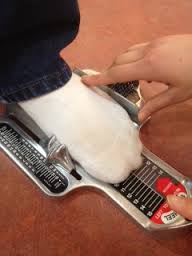 Did you know that Thursday (Jan. 23) was Measure Your Feet Day? No?? Well, I didn’t know it either. And, yes, it really is a recognized holiday. Although no one seems to know how it originated.
Did you know that Thursday (Jan. 23) was Measure Your Feet Day? No?? Well, I didn’t know it either. And, yes, it really is a recognized holiday. Although no one seems to know how it originated.
But why not have a holiday recognizing the importance of measuring your feet. After all, think about how much your feet support you and enable you to go about your daily tasks every day.
When you know your correct measurements, you can purchase shoes that properly fit your feet. Otherwise, when you wear shoes that don’t fit correctly, you may experience foot pain. Plus, you increase your risk of developing foot problems, like corns, calluses, bunions and hammertoe.
So, if you haven’t measured your feet in a while, take the time to have your feet measured properly by a professional soon. And follow these steps to ensure you get the best fit when purchasing shoes.
- Have your feet measured at least once a year, so you know your correct foot size. The size of your feet can increase or decrease throughout your life.
- Measure your feet and try on shoes at the end of the day. Your feet are at their largest at the end of the day due to swelling.
- Have your feet measured and try on shoes with socks (the ones you plan to wear with that pair of shoes, such as thin nylons for dress shoes and thicker socks for athletic shoes). Sock weight can affect how your shoes fit.
- Have your feet measured with a Brannock measuring device. This device measures your feet for the correct toe length (the length from your longest toe to your heel), arch length (the length from your heel to the ball joint of your foot) and foot width (the width across the ball of your foot). Your foot width is particularly important, because it determines how narrow or wide your shoes should fit.
- Have both feet measured. Although your feet are a pair, they can be individual sizes. In fact, it’s normal to have feet that are two different sizes. Have your shoes fitted to the largest foot size. The smaller foot’s shoe can be altered for a proper fit.
- Your arch length is your reference point when choosing a size. In correctly fitted shoes, the arch of the shoe and the ball joint of the foot will be properly aligned. The ball of your foot should fit snugly, but comfortably, in the ball joint area (sometimes referred to as the cradle) of your shoe. Your foot and shoe should bend at the same location, and your arch should be fully supported. Shoes that are improperly fitted and too short for your arch length will confine your toes. If you can feel the sides of your shoe with your toes, the shoe is too tight. Shoes that are too tight can cause foot discomfort and fatigue. They also can affect your gait.
- Select shoes that fit to the shape of your foot – not the number. Shoes vary from company to company. A size 8 shoe from one manufacturer may not fit the same as a size 8 shoe from another company. If your feet are slender and tapered, shoes with a tapered-toe-box shape will fit better. If your feet are fleshier and broader, shoes with a square toe box will fit better.
- Look at the shoelaces to determine if the shoe fits properly. There shouldn’t be more than 1 inch of space between your shoelaces. A shoe is too wide if there is less than an inch between the laces or the upper material of the shoe touches. A shoe is too tight if there is more than an inch between the laces. Also, if your shoelaces are tied too tightly, the top of your foot may become numb and tingle.
- Ensure the heel counter is firm. The heel counter is the upper part of the shoe that the heel of your foot sits in. It’s attached to the sole of the shoe, but it’s not part of the actual heel. A firm heel counter enables proper motion of the foot and even weight distribution as your foot makes contact with the ground. When our heels strike the ground as we walk, our feet naturally turn out as we walk. But if your feet turn out too much, or if they turn in, your feet need more stability. A strong heel counter can help correct these problems.
- Visit a pedorthic shoe store for a professional, personalized shoe fitting if you have any foot problems. A thorough shoe fitting/buying consultation may take up to 1 hour.
- If you have foot conditions or gait issues, you may want to purchase ezWalker® Performance Custom Orthotics for your shoes. Custom-made, biomechanically designed insoles, like ezWalker® custom orthotics, can realign your body by providing your feet with more support and a proper foundation in your shoes. The ezWalker® Performance Custom Orthotic also helps reduce or eliminate foot pain. No matter what type of shoes you need to wear, there is an ezWalker® Custom Orthotic to help you maintain all-day comfort and pain relief. Order your ezWalker® Performance Custom Orthotics today.
- Refer to the Shoe Fitting Guide at the WalkEzStore for more information on foot measurements, shoe sizing, and how to obtain a proper shoe fit – especially with ezWalker® Custom Orthotics.
By following these tips, you can help keep your feet healthy and prevent any foot problems from occurring.
So, put ezWalker® Custom Orthotics in your shoes and put a smile on your face. Because … when your feet feel good, you feel good!®

